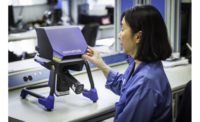The success of any food safety program depends on many factors, including but not limited to controlling contamination, Standard Operating Procedures, Good Manufacturing Practices, hygienic equipment design, training, risk assessment, Hazard Analysis and Critical Control Points plans, personal hygiene, pest control and a reliable workforce (see “‘Everybody Owns Food Safety’ in Action”). It is a very complex system with many interdependent parts, and the most critical factor is the workforce, because employees monitor, control and correct as well as contribute to many of the food safety issues we face each day. Complicating matters is the fact that this workforce is changing quickly. The profile of the nation’s workforce continues to diversify and increasingly it is made up of people who may not speak English or speak English as a second language.[1] The Hispanic population is the fastest-growing ethnic minority group in the U.S., and a large percentage find at least their initial employment in the food industry.[2] This creates an environment where many non-English languages are spoken at home and on the job.
According to economists, limited English skills of foreign-born U.S. workers cost U.S. corporations $65 billion annually in lost productivity.[3] Managers may perceive this lack of a common language at work as a source of frustration, which may reduce their effectiveness.[4] Tension, misunderstandings about work, safety risks, inefficiencies and the inability to communicate effectively with supervisors all can escalate when people speak in different languages.3 Additionally, non-English-speaking groups are more reluctant than English-speaking employees to communicate issues such as safety practices, specifically, food safety practices with managers.[4]
Attitudes, Behavior and Culture
Employee attitudes toward specific behaviors have been identified as predictors for overall employee behaviors and food safety in general.[5] Although attitudes may be important factors in predicting behavior, the question must be asked whether employee attitudes toward food safety differ between English and non-English speakers, therefore making it more challenging for managers to communicate safe food handling procedures. Food safety classes are offered in multiple languages such as Spanish or Chinese; however, many of these classes do not address behaviors strengthened by differences in cultural upbringing.[6]
Cultural background and upbringing, justification and/or motivation for a particular behavior may influence improper food safety behaviors in certain employees; therefore, there may be common cultural misconceptions concerning food safety. Collectivist cultures, such as those in Mexico and other Latin American countries, tend to focus on the interest of a group, a family or extended relationships, rather than on individual interests or concerns. Therefore, not only do managers need to address communication barriers, they need to be culturally aware of cultural misconceptions concerning food safety that must also be addressed. Food safety culture is management-driven, but what is driving our quality assurance managers and processing line supervisors?
Management Challenges: Where to Begin?
Other challenges that quality assurance managers and processing line supervisors face when teaching food safety to new employees include working with an entry-level, low-skilled labor force and high employee turnover rates. Based on levels of education, non-English speakers may or may not be able to read in their native language, so translating food safety training material into additional languages may not be effective. The U.S. Census Bureau noted that by the end of 2015, the Hispanic population will double in size compared with 1990.[7] As one of the largest employers of Hispanics, the food industry must focus its efforts on training non-English speakers in food safety. Offering training materials written in Spanish or other languages may be a limited start but may not be a complete solution. By doing so, the assumption is made that all workers are visual learners and that all have similar reading levels. In addition, young people entering the workforce may be more familiar with computers and online training. Due to the notoriously high turnover rates of the food industry, managers may not want to invest a lot of time, money or effort into developing food safety training programs for an individual employee, because within months of receiving this training, the employee may leave.[6] Frontline managers and shift leaders must identify where cultural barriers to food safety exist, learn effective methods for communicating proper food safety practices to non-English speakers and develop a delivery method that is rapid and effective. So where should managers begin? The following steps can be taken to implement best practices for overcoming these training challenges:
1. Nonverbal Communication. Nonverbal behavior is paramount when communicating in an environment where communication barriers exist. Facial expressions, such as eye contact, and expressing positive emotions like smiling or laughing and hand gestures are simple gestures but significant for cross-cultural communication. When cutting, trimming or preparing raw ingredients, demonstrating how to use protective safety clothing like gloves and arm guards can help ensure employees will follow proper procedures. And wear them correctly.
2. Be Positive, Patient and Empathetic. Research has shown that if someone is placed in an environment where they cannot understand the language and verbally communicate, they empathize with others who face this situation and have more positive attitudes toward them.[8] Positive feedback must be given, even if it is nonverbal. As simple as this may seem, it will increase productivity and overall quality. As a result, non-English-speaking employees may become more content with coworkers and the management team, which may help reduce turnover rates. Often, new employees focus much of their attention on not making mistakes and trying to assimilate into the group as fast as possible. Knowing that this is universal regardless of the language being spoken can help managers bridge communication gaps and help new employees “on-board” quicker into the organization. This takes pressure off the new employees and will allow them to focus on the task at hand and actually learn the skills needed to perform the job.
3. Language Classes. Often, employers focus on teaching frontline employees English through after-work programs, with local junior colleges or other programs. This is a great incentive for employees and demonstrates that the employer is interested in the employee as an individual and not just as a worker. At the same time, employers may consider offering classes for managers, shift leaders and key employees in other languages such as conversational Spanish, Vietnamese or Mandarin. Many of these courses are available online and are conversation-focused and inexpensive. The ultimate goal is to increase communication between managers and employees. Meeting the employee halfway may be a good start.
4. Pictures and Photographs. Pictures and photographs of procedures not only can guide employee performance but also can improve job performance, task satisfaction and job commitment. Like language classes, pictures can be perceived as an investment, support or signal that the organization cares about the employees’ well-being, and in return, employees will reciprocate the benefits they received through job commitment and task satisfaction. Working in an environment with communication barriers can intensify role ambiguity; providing pictures or photographs reduces these ambiguities. Visual cues are also important for completing complex tasks on production lines. Any visual cues that can help in the decision-making process concerning acceptance or the rejection of shipments are helpful. Images of raw products being converted into food product outputs should be included throughout the entire processing line. Subtle prompts such as employees wearing gloves in the pictures will help remind employees to wear gloves when appropriate. Additionally, posting pictures of how to organize and store raw and finished products in a walk-in refrigerator or freezer will help eliminate uncertainty and will help keep things organized and help with proper product rotations.
5. Zones. There are many opportunities for injury within food processing plants. One possible solution may include zoning high-risk areas and high-injury areas within the facility to alert employees of possible incidents and accidents. This may include painting or marking critical areas to communicate nonverbally potential risks, which may in fact change employee behavior. By controlling foot traffic in cooking or cooling zones, you can reduce cross-contamination from both employees and equipment.
Postprocess Contamination
The U.S. Food and Drug Administration defines postprocess contamination by pathogens, chemicals, allergens or foreign objects as the adulteration of a finished food product after processing at the manufacturing facility so that the food is no longer wholesome or safe, therefore rendering the finished product unsafe to eat.[9] Postprocessing contamination may occur between lethality treatments, such as cooking to a prescribed internal temperature, and packaging or postpackaging contamination at the processing plant. While postprocess contamination is responsible for spoilage of many canned foods, it has also caused a number of outbreaks of foodborne disease. Studies show that approximately 25 percent of all foodborne illness outbreaks could be traced back to postprocess contamination. The most significant factors contributing to the presence of pathogens in the food were poor personal hygiene, cross-contamination, inadequate storage, contaminated equipment and contamination by personnel.
What’s at Stake?
Foodborne illness devastates the lives of millions and takes a significant toll on the economy locally and nationally. Expenses may include medical treatment, lost wages, loss of the business’s reputation, lost sales, food items that must be discarded and expenses associated with cleaning the facility. Estimated costs of foodborne illness in the U.S. are said to be $152 billion annually, with a single pathogen, Listeria monocytogenes.
Sources of Contamination
Several studies have reported that contamination within food processing facilities has been the source of L. monocytogenes more often than raw food commodities.[10–14] One possible explanation for this is that L. monocytogenes can adhere to and create biofilms on stainless steel and other materials commonly found in food processing facilities.[15-16] Slicing and chopping machinery has been implicated in foodborne illnesses including typhoid fever, hepatitis C, salmonellosis and listeriosis.[17–19] Researchers have investigated possible routes for cross-contamination of L. monocytogenes between processing equipment and delicatessen meats and reported that commercial slicers and similar types of equipment can transfer L. monocytogenes onto food products, depending on microbial load found on the equipment.[16] Other contributing factors included the types of food product and the design of the equipment.
Three large listeriosis outbreaks from 1998 through 2002 were linked to turkey delicatessen meat contaminated in the processing plant after cooking.[20–22] In addition, dairy products have been identified as the second-most-frequent food source for infections causing illness (14%) and deaths (10%). In the U.S., dairy products are commonly consumed after pasteurization, which eliminates harmful bacteria, but improper pasteurization and postprocessing contamination do occur. Several norovirus outbreaks have been associated with cheese, demonstrating the role of contamination of dairy products postpasteurization by food handlers.[23] Unfortunately, due to the tremendous volume of dairy products consumed in the U.S., even infrequent contamination of commercially distributed products can cause many illnesses.[24] Lin et al.16 stated that proper cleaning and sanitizing could prevent L. monocytogenes on previously contaminated food processing equipment. Therefore, emphasis must be placed on food safety training for food workers, more specifically, proper methods for cleaning and sanitizing food processing equipment.
Listeria monocytogenes
L. monocytogenes is responsible for a large percentage of these costs.25 Listeria is widespread in soil, water vegetation and wild and domestic animal feces that may be found on farms and then transferred into food processing facilities.[26, 27] L. monocytogenes in particular can cause long-term heath issues, which may account for such an extremely large portion of the cost burden. Listeriosis can be defined as cases of L. monocytogenes that infect normally sterile parts of the body such as the liver, spleen, cerebrospinal fluid and blood, with 89 percent of patients requiring hospitalization.[27, 28] Symptoms for healthy adults may include diarrhea and fever; but for pregnant women, who account for about 30 percent of diagnosed cases, symptoms may include fever, diarrhea, miscarriage or stillbirth. Newborns may contract sepsis, meningitis or pneumonia.
Conclusion
Behavior change can be complex and multiple approaches are needed. One approach is to identify the causes or barriers to desirable behaviors in order for the problem to be addressed in the proper context for changes to be made. For example, trainers need to understand why food employees do not clean the equipment properly: What is preventing them from doing their job? Do they have the right tools? What are the barriers? Employees’ perception of barriers for cleaning work surfaces includes time constraints, inadequate training, forgetting, lack of adequate resources, management and employees not caring, competing tasks and inconvenience. Therefore, these barriers must be addressed within the food safety training program. By implementing simple tasks such as making eye contact, smiling, being positive and empathetic, offering language classes, using pictures and photographs to guide employee behaviors and strategic zoning, food safety risks can be reduced despite language barriers.
Jay Neal, Ph.D., is an associate professor in the Conrad N. Hilton College of Hotel and Restaurant Management at the University of Houston.
Philip G. Crandall, Ph.D., is a professor in the department of food science at the University of Arkansas.
Mary Dawson, Ph.D., is the interim associate dean of academic programs and associate professor in the Conrad N. Hilton College of Hotel and Restaurant Management at the University of Houston.
Juan Madera, Ph.D., is an associate professor in the Conrad N. Hilton College of Hotel and Restaurant Management at the University of Houston.
References
1. Canziani, B.F. 2006. Managing language policies in the foodservice workplace: A review of law and EEOC guidelines. J Foodservice Bus Res 9:27–47.
2. Humes, K.R., N.A. Jones and R.R. Ramirez. 2011. Overview of race and Hispanic and underrepresented origin: 2010. U. S. Census Bureau. Washington, DC.
3. www.entrepreneur.com/magazine/entrepreneur/1998/december/16838.html.
4. Loosemore, M. and P. Lee. 2002. Communication problems with ethnic minorities in the construction industry. Int J Project Manag 20:517–524.
5. Pilling, V.K. et al. 2008. Identifying specific beliefs to target to improve restaurant employee’s intentions for performing three important food safety behaviors. J Amer Diet Assoc 108:991–997.
6. Niode, O., C. Bruhn and A.H. Simmone. 2010. Insight into Asian and Hispanic restaurant manager needs for safe food handling. Food Cont 22:34–42.
7. www.census.gov/population/projections/files/stateproj/ppl47.pdf.
8. Madera, J.M., J.A. Neal and M. Dawson. 2011. Strategies for diversity training: Focusing on empathy in the workplace. J Hosp Tour Res 35:469–487.
9. www.fda.gov/Food/GuidanceRegulation/CGMP/ucm110966.htm.
10. R´ørvik, L.M., D.A. Caugant and M. Yndestad. 1995. Contamination pattern of Listeria monocytogenes and other Listeria spp. in a salmon slaughterhouse and smoked salmon processing plant. Int J Food Microbiol 25:19–27.
11. Nesbakken, T.G., G. Kapperud and D.A. Caugant. 1996. Pathways of Listeria monocytogenes contamination in the meat processing industry. Int J Food Microbiol 31:161–171.
12. Autio, T. et al. 1999. Sources of Listeria monocytogenes contamination in a cold-smoked rainbow trout processing plant detected by pulsed-field gel electrophoresis typing. Appl Environ Microbiol 65:150–155.
13. Miettinen, M.K., K.J. Björkroth and H.J. Korkeala. 1999. Characterization of Listeria monocytogenes from an ice cream plant by serotyping and pulsed-field gel electrophoresis. Int J Food Microbiol 46:187–192.
14. Berrang, M.E., R.J. Meinersmann, J.K. Korthcutt and D.P. Smith. 2002. Molecular characterization of Listeria monocytogenes isolated from a poultry further processing facility and from fully cooked product. J Food Prot 65:1574–1579.
15. Beresford, M.R., G. Shama and P.W. Andrew. 2001. Listeria monocytogenes adheres to many materials found in food-processing environment. J Appl Microbiol 90:1000–1005.
16. Lin, C.M. et al. 2006. Cross-contamination between processing equipment and deli meats by Listeria monocytogenes. J Food Prot 69:71–79.
17. Howie, J.W. 1968. Typhoid in Aberdeen, 1964. J Appl Bacteriol 31:171–178.
18. Vorst, K.L., E.C.D. Todd and E.T. Ryser. 2006. Transfer of Listeria monocytogenes during mechanical slicing of turkey breast, bologna, and salami. J Food Prot 69:619–626.
19. Bocket, L. et al. 2011. Occupational transmission of hepatitis C virus resulting from use of the same supermarket meat slicer. Clin Microbiol Infect 17:238–241.
20. Olsen, S.J. et al 2005. Multistate outbreak of Listeria monocytogenes infection linked to delicatessen turkey meat. Clin Infect Dis 40:962–967.
21. Gottlieb, S.L. et al. 2006. Multistate outbreak of listeriosis linked to turkey deli meat and subsequent changes in US regulatory policy. Clin Infect Dis 42:29–36.
22. Mead, P.S. et al. 2006. Nationwide outbreak of listeriosis due to contaminated meat. Epidemiol Infect 134:744–51.
23. Painter, J.A. et al. 2013. Attribution of foodborne illnesses, hospitalizations, and deaths to food commodities by using outbreak data, United States, 1998–2009. Emerg Infect Dis 19:407–415.
24. Ryan, C.A. et al. 1987. Massive outbreak of antimicrobial-resistant salmonellosis traced to pasteurized milk. JAMA 258:3269–3274.
25. www.makeourfoodsafe.org/cost_map.
26. Sauders, B.D. and M. Wiedmann. 2007. “Ecology of Listeria species and L. monocytogenes in the natural environment.” In Listeria, listeriosis and food safety, edited by E.T. Ryser and E.H. Marth, 21–53. New York: Marcel Dekker.
27. Todd, E.C.D. and S. Notermans. 2011. Survival of listeriosis and its causative pathogen, Listeria monocytogenes. Food Cont 22:1484–1490.
28. wwwn.cdc.gov/foodborneoutbreaks/.




